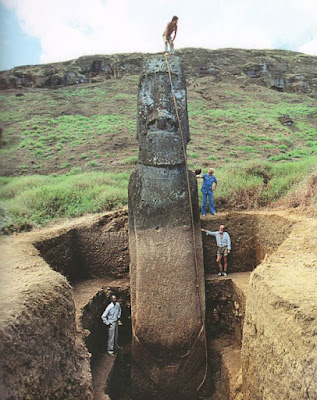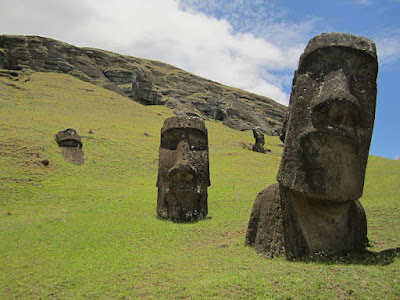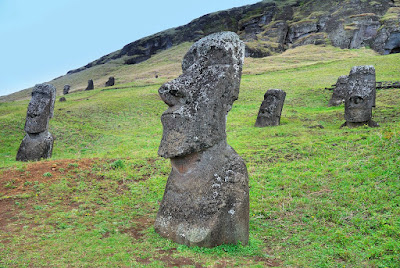Easter Island, renowned for its iconic stone head statues known as moai, holds a hidden secret beneath the earth's surface. While archaeologists have documented 887 of these monumental sculptures, it is believed that there could be as many as 1,000 scattered across the island. Carved from volcanic rock between 1100 and 1680, the moai have fascinated researchers and visitors alike.
 |
| Credit: Easter Island Statue Project |
Unlike many other historic archaeological sites, the sheer size of the Easter Island statues has deterred theft. However, it was not widely known until recent years that the moai possess complete bodies concealed beneath the ground. While photographs of the statues undergoing excavation circulated in 2012, the bodies had actually been known to archaeologists since the early 20th century.
Approximately 150 statues are buried up to their shoulders on the slope of a volcano, making them the most famous and visually striking of all the Easter Island statues. Prior to the release of excavation photos, these buried torsos were often mistaken for head-only statues. The discovery of complete bodies brought widespread attention to the Easter Island Statue Project, with their website crashing due to a surge of interest and millions of online hits.
 |
| Credit: Easter Island Statue Project |
Leading the project, director Jo Anne Van Tilburg and her team conducted meticulous excavations in 2010, providing the first comprehensive scientific documentation of the moai. This ground-breaking work shed light on the importance of delving beneath the surface to unravel the mysteries surrounding these ancient sculptures. Tilburg's excavations captured the imagination of people worldwide, fueling a renewed fascination with Easter Island and its enigmatic stone heads.
 |
| Credit: Easter Island Statue Project |
As visitors continue to explore Easter Island, the hidden torsos of the moai serve as a reminder of the island's rich history and the enduring allure of its ancient past. The ongoing research and discoveries surrounding these remarkable statues offer valuable insights into the island's cultural heritage, leaving us in awe of the artistic achievements of the ancient Rapa Nui civilization.
 |
| Credit: Easter Island Statue Project |
With the newfound understanding of the Easter Island statues, the story of this remote island in the Pacific Ocean becomes even more captivating. The buried torsos add depth to the narrative, inviting us to contemplate the remarkable craftsmanship and cultural significance of these monumental sculptures. As researchers continue their investigations, the secrets of Easter Island's stone head statues are gradually unveiled, providing a fascinating glimpse into a bygone era.
History of Easter Island
Easter Island, also known as Rapa Nui, is a remote Polynesian island located in the south-eastern Pacific Ocean. The island is renowned for its iconic stone head statues, called moai, which have fascinated the world for centuries. While Easter Island is famous for these enigmatic sculptures, it also boasts a rich and intriguing history.
The earliest settlers of Easter Island are believed to have arrived around 1200 CE, originating from other Polynesian islands. These early inhabitants developed a unique culture and society over the centuries. The moai statues, carved from volcanic rock, emerged as a prominent feature of their civilization.
The construction of the moai began around the 13th century and continued until the late 17th century. These colossal statues, ranging in height from a few meters to over 20 meters, were created to honor ancestral chiefs and other important figures. The precise techniques used to carve and transport these massive stone figures remain a subject of debate and speculation.
By the time European explorers arrived in the 18th century, Easter Island had undergone significant changes. The island's resources, including its lush forests, had been depleted, leading to ecological decline and social unrest. Conflicts and competition over limited resources had a profound impact on the island's population.
One of the enduring mysteries surrounding Easter Island is the collapse of its civilization. By the time Europeans encountered the island, its society had undergone a significant decline. The exact reasons for this collapse are still debated among researchers, but factors such as deforestation, overpopulation, social unrest, and resource depletion likely played a role.
European contact with Easter Island had a profound impact on its native population. The island was visited by various explorers and traders, and later came under the control of different colonial powers, including the Spanish and the Dutch. These encounters brought diseases, forced labor, and cultural disruptions to the island's inhabitants.
In the 19th and early 20th centuries, Easter Island saw further waves of colonization and changes in governance. In 1888, Chile annexed the island, and it remains an overseas territory of Chile to this day. Efforts to preserve and study the island's cultural heritage have been ongoing, with archaeological research shedding light on the island's fascinating past.
Today, Easter Island is recognized as a UNESCO World Heritage site, attracting visitors from around the world who come to witness the awe-inspiring moai statues and explore the island's captivating history. Efforts are being made to preserve the island's natural environment and cultural heritage, ensuring that future generations can continue to marvel at the remarkable legacy of Easter Island's ancient civilization.
Articles you might likes:



